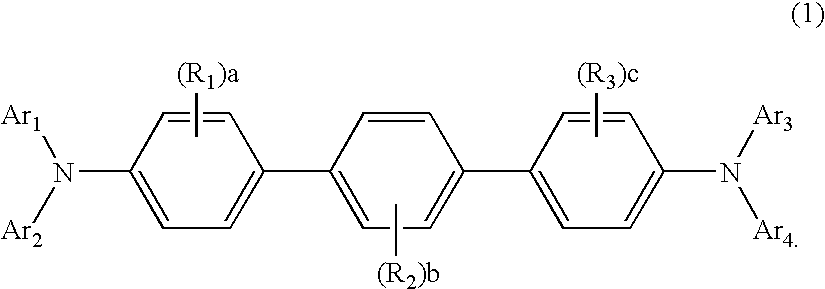Aromatic amine derivative and organic electroluminescence device using the same
a technology of organic electroluminescence and amine, which is applied in the direction of organic semiconductor devices, discharge tube luminescnet screens, organic chemistry, etc., can solve the problems of reduced current efficiency of light emission, reduced lifetime of light emission, and increased driving voltage of light emission, so as to reduce the tendency for molecular crystallization and enhance the yield of fabricating , the effect of long lifetim
- Summary
- Abstract
- Description
- Claims
- Application Information
AI Technical Summary
Benefits of technology
Problems solved by technology
Method used
Image
Examples
synthesis example 1
Synthesis of Compound H1
[0156] Under an argon gas flow, 5.8 g of Intermediate 1, 5.9 g of Intermediate 2, 2.7 g of t-butoxy sodium (available from HIROSIMA WAKO CO., LTD.), 186 mg of tris(dibenzylideneacetone) dipalladium(0) (available from ALDRICH CO., LTD), 82 mg of tri-t-butylphosphine and 200 mL of dehydrated toluene were placed and the reaction was allowed to proceed at 80° C. for 8 h.
[0157] The resultant solution was cooled down, added with 500 ml of water and filtered through sellite. The resultant filtrate was extracted with toluene, and the extract was dried over dehydrated magnesium sulfate. The dried product was condensed under reduced pressure and the crude product was purified through a column. The purified product was re-crystallized from toluene and the crystal collected by filtration was dried, to obtain 4.6 g of pale yellow powder, which was analyzed by FD-MS (Field Desorption Mass Spectrum) and identified as Compound H1 from the main peak of m / z=817 attributable ...
synthesis example 2
Synthesis of Compound H2
[0158] Reaction was conducted in the same manner as Synthesis Example 1 except that 7.4 g of Intermediate 3 was used instead of Intermediate 2, to obtain 5.3 g of pale yellow powder, which was analyzed by FD-MS and identified as Compound H2 from the main peak of m / z=969 attributable to C74H52N2=969.
synthesis example 3
Synthesis of Compound H3
[0159] Reaction was conducted in the same manner as Synthesis Example 1 except that 4.2 g of N-phenyl-1-naphthylamine was used instead of Intermediate 2, to obtain 3.1 g of pale yellow powder, which was analyzed by FD-MS and identified as Compound H3 from the main peak of m / z=664 attributable to C50H36N2=664.
PUM
| Property | Measurement | Unit |
|---|---|---|
| Structure | aaaaa | aaaaa |
| Temperature | aaaaa | aaaaa |
Abstract
Description
Claims
Application Information
 Login to View More
Login to View More - R&D
- Intellectual Property
- Life Sciences
- Materials
- Tech Scout
- Unparalleled Data Quality
- Higher Quality Content
- 60% Fewer Hallucinations
Browse by: Latest US Patents, China's latest patents, Technical Efficacy Thesaurus, Application Domain, Technology Topic, Popular Technical Reports.
© 2025 PatSnap. All rights reserved.Legal|Privacy policy|Modern Slavery Act Transparency Statement|Sitemap|About US| Contact US: help@patsnap.com



